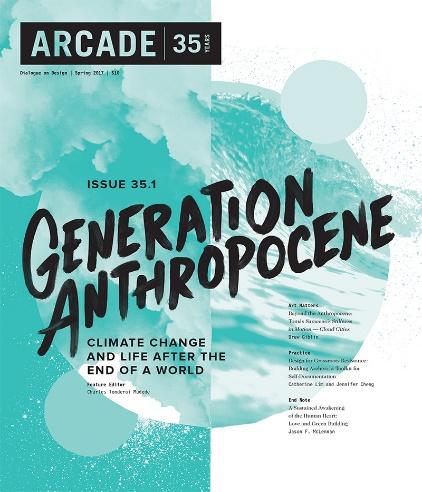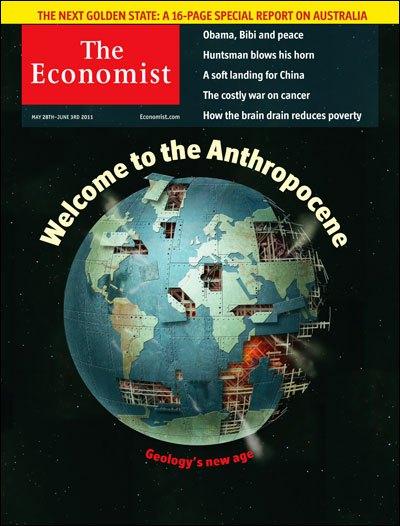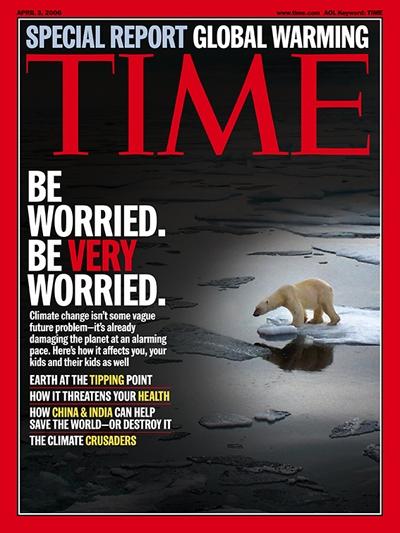Editors’ Introduction for NANO Special Issue 13: The Anthropocene
by Kyle Wiggins and Brandon Krieg
Published December 2018
In 1992 at a New York City club, George Carlin did eight minutes of stand-up comedy about environmentalism. Like many of his routines, this one targeted something just beyond its immediate aim. While Carlin ridiculed the effectiveness of green living, he also lampooned the hypocrisy of humanity.
Humans don’t give a shit about the planet, Carlin argued. Not in any genuine sense. Recycling, conservation, clean energy—these efforts aren’t made for the environment. People only care about deforestation or ocean temperatures because it benefits them. If Earth becomes uninhabitable, life gets hard. So when humans voice ecological concerns, they really express worries about their own longevity. The charade, as Carlin sees it, is a motivational one. Altruism doesn’t drive environmentalism as folks claim. Selfishness does.
Carlin’s comedy routine turns on a suspicion that, at the root of everything, humans are egoists. They are only out for themselves. And all of their eco politics, stripped of ideological dressings, do more to protect the species than the natural world surrounding it.
Of course, two glitches trouble Carlin’s reasoning. First, by pitting humans against nature as antagonistic forces—instead of recognizing their symbiotic (or at least interconnected) relationship—the comedian recapitulates the very thinking he critiques. Second, for a crusty pragmatist, Carlin’s gripe is weirdly idealistic: is environmentalism really upright only when it is purely altruistic?
Setting aside the morality of motivation, though, Carlin’s routine offers an important insight. The environment may not actually be at the center of environmental movements. Human life is. To act otherwise is a ruse.
The novelist N.K. Jemisin confronts that anthropocentrism in her dystopian epic The Fifth Season: “This has happened before, after all. People die. Old orders pass. New societies are born. When we say ‘the world has ended,’ it’s usually a lie because the planet is just fine” (14). Matt Bell’s Scrapper renders civilization’s decay in similar fashion. Bell’s protagonist, Kelly, prowls the industrial wasteland of Detroit—a setting that feels contemporary and futuristic—hunting for scrap metal and wire. Standing in the husk of an abandoned factory, Kelly sees the area operating “outside of the time marked by digital clocks, smartphone calendars. Inside the zone events moved along paths solar, lunar, seasonal: new geological epochs marked by strata of waste” (24). From his vantage, the scrapper ponders what this great collapse foretells.
Kelly pretended he carried the last human gaze door-to-door, window to window, exploring the first outpost of a culture pushed past repair. It could be destroyed but could it be fixed? All the better futures might not arrive. He didn’t think his was the final generation, but perhaps the last might already be born.
What did this mean for him, for the good man he had tried and failed to be? (24)
Because humans occupy a dominant but also tenuous position on Earth, we constantly imagine the world ending when our own fire goes out. Though planetary existence will go on long after we vanish, people cannot think beyond our own perception, leading us to equate our species with all life itself. What does it mean, then, to be human—even a human environmentalist—on a planet imperiled by our presence?
That question underlies this special issue of NANO on the Anthropocene.
In the Anthropocene—our geologic present, defined by human dominance in the world—calamity is familiar. Every day, new reports, think pieces, and warnings emerge about the bleak prospect of life on Earth. Many of these dispatches from academia, media cycles, and even popular culture assess the planet on the brink of crisis.



As Jeremy Davies puts it in The Birth of the Anthropocene, “Earth’s atmosphere, oceans, rocks, plants, and animals are experiencing changes great enough to mark the ending of one epoch and the beginning of another” (2). We have entered a moment of environmental change, yet the concept of “Anthropocene” continues to be used in “diverse, contested, and even incompatible ways” and its impact on humanity remains much debated (6). In simple terms, humans are still sorting out what this new moment signifies for us.
A brief survey of the growing work on the Anthropocene bears out this uncertainty. For McKenzie Wark, the Anthropocene is “a world on fire” (Molecular Red, xiv); however, Wark sees opportunity in this unsettling, a potential reorganization of time and material resources that might generate an enduring relationship between humanity and nature. Jane Bennett finds a related opportunity in the Anthropocene to extend our conception of material geology to include human bodies, noting that humans “are made of the same elements as is the planet,” and that, “Like wind or river, human individuals and groups are geologic forces that can alter the planet in countless and, as the concept of the Anthropocene marks, game-changing ways” (“Earthling, Now and Forever?”). Bennett proposes an ethic of “self” as coextensive with other geologic material as crucial to promoting human survival:
For me, one of the effects of a heightened awareness of the interpenetration of the human and ahuman geologic is that it stretches my definition of ‘self’-interest to include the flourishing of the complex system of bio-geologic processes. This enriched understanding of ‘self’ would then, I hope, enable a more extended pursuit of our conatus, the endeavor to persist in being.
In a most apocalyptic take, Roy Scranton argues that the “biggest problem we face” in the era of climate change “is a philosophical one: understanding that this civilization is already dead” (“Learning How to Die in the Anthropocene”). Nothing can rescue our doomed species.
By definition, the Anthropocene is categorically narcissistic. It situates humans as the prevailing force (of life, of change) on the planet. If our heads swell with self-importance, it’s for good reason: for better or (usually) worse, we can alter existence on Earth. This is historically unprecedented power for a single species.
As the Anthropocene comes into vogue, it poses for all disciplines an ethical quandary about what life is possible tomorrow. It invites critical thinking about the limits of the human, and the consequences of human narcissism and self-interest. Carlin, Bell, and Jemisin (to a lesser degree) believe the Anthropocene’s apocalyptic warbling sounds like delusion. To what degree are they right? Does fessing up to a vested interest in slowing climate change make one’s politics greener or more authentic? Is it wrong to prioritize human longevity? Where do the humanities go in the Anthropocene? Can an environmental call-to-arms rescue the planet?
Contributors to this issue answer those pressing questions in a variety of ways. In “Envisioning a New Anthropocenario,” Serpil Oppermann contends that our present requires a mode of storytelling better capable of narrating the experience of multiple, interconnected species. Leaning heavily on material ecocriticism, Oppermann displaces the human storyteller as the central voice of the Anthropocene, installing a chorus of coexistent matter in its place. This artistic, critical, and philosophical strategy, Oppermann believes, will enable humans to recognize the interdependent reality of life in the Anthropocene. In the next article, Simon C. Estok considers whether the Anthropocene, as a theoretical term, is necessary for understanding the realities of climate change. Estok makes the case that the Anthropocene has been used too often and without rigor, leading to a serious misunderstanding of its origins and meaning. He critiques the concept’s limitations, offering a new ethical response to radical alterations of our biosphere. In the final article, Joelle Renstrom rebuts the transhumanist movement’s aspiration to end the suffering of all sentient beings. By advocating for rampant genetic modification, Renstrom argues, transhumanists dismiss the scientific value of pain. Moreover, she finds that transhumanist technological solutions to ecological challenges would be available only to the super rich.
This special issue of NANO: New American Notes Online also features interviews with brilliant thinkers in the nascent field of the Anthropocene. In the first conversation, Jill Magi discusses her eco-poetic chapbook, Sign Climacteric, with Brandon Krieg and the challenges of responding poetically to changes in the natural world. With the help of programmer Pierre Depaz, Magi captures environmental turmoil within the “degrading” form of her digital text. In the second interview, David Kreps, author of Against Nature, explains to Kyle Wiggins how information systems theory, philosophy, and ecology intersect in the Anthropocene and can yield a sustainable future for Earth. Kreps thoroughly details the impediments to comprehending climate change within the academy and outside of it. Each article and interview tracks a different dilemma facing humans at a moment of uncertainty, and each advocates an urgent response to a planet in crisis.
This issue of NANO appears in the shadow of the U.N.’s special report on climate change http://www.ipcc.ch/report/sr15/. An intergovernmental panel of scientists concluded, among other things, that the planet might experience massive food shortages, ocean habitat loss, and wildfires as soon as 2040. Moreover, if greenhouse gas emissions continue at their current rate, warming the atmosphere 1.5 degrees Celsius above pre-industrial temperatures, coastal flooding and inland droughts are inevitable. The report warns that poverty, violence, and massive disaster relief costs could follow. It’s a grim forecast, and leaves one unsure if anything can shield humanity from a damnation of its own design.
The U.N. climate report raises the possibility that we inhabit a realm of looming resource deprivation and insane heat. In other words, while today is worrisome tomorrow will be much worse. If this is true, what does it mean for our daughters and sons? Have we drawn our children into a blighted world? Or, from a different angle, have we cursed an already overcrowded rock with even more carbon consumers? Prophecies like the U.N. climate report lay out a darkest fear: a world irrevocably lost.
All things end. Though living without a future seems like the worst closure of all.
But to us, that sort of apocalypticism is paralyzing (politically, ethically, and practically). If the only sound the Anthropocene issues is despair, then it signifies nothing meaningful. If, however, the Anthropocene alerts us to the planet’s dimming, but not yet dark, horizon, then hope remains. Perhaps the challenge of the Anthropocene lies in recognizing the oddity of the human animal in its environs. We are the dominant power on this planet. Now we need to think beyond that reality, for it too shall pass.
Editors’ Acknowledgement: The editors would like to thank Samuel Fee, Professor of Computing and Information Studies at Washington & Jefferson College, for helping develop the issue’s visual themes and for providing its photographs.
Works Cited
Bell, Matt. Scrapper. Soho, 2015.
Bennett, Jane. “Earthling, Now and Forever?” In Making the Geologic Now: Responses to Material Conditions of Contemporary Life. Edited by Elizabeth Ellsworth and Jamie Kruse. http://www.geologicnow.com/after_Bennett.php
Davies, Jeremy. The Birth of the Anthropocene. U of California P, 2016.
Jemisin, N.K. The Fifth Season. Hachette, 2015.
Scranton, Roy. “Learning How to Die in the Anthropocene.” New York Times, Nov. 10, 2013. https://opinionator.blogs.nytimes.com/2013/11/10/learning-how-to-die-in-the-anthropocene/
Wark, McKenzie. Molecular Red: Theory for the Anthropocene. Verso, 2015.


